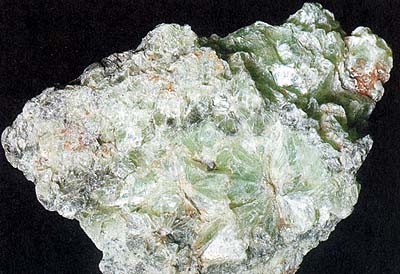Stone, minerals and semiprecious of the world stone
Amphiboles (silicates): Talcum, talc -->rus
 Diagnostic cart.
Diagnostic cart.
On a photo - a variety of talc is a potstone. Down: classic aggregate of talc
Mg3 (OH)2 Si4O10
Crystal structure monoclinic
Hardness on the Mohs scale 1
Specific unit weight mass 2,58-2,83
Cleavage perfect absolute
Fracture, break wrong
Colors colourless, multicolors
Colors in powder triturate white
Glance (glitter, glare) from fat to mother-of-pearl
Talc is a silicate of magnesium. Transparent in thin leaves or opaque. Colors: greyish-white, light-green, brownish. A line is white. Fracture, break uneven. Bent easily, but not elastic. Cleavage very perfect absolute. Fat by touch. Crystals (monoclinic Crystal structure) are rare. Usually forms scaly aggregates. Dense aggregates, reminding pork fat or stearin by appearance, name a potstone (by a steatite, soapstone, "fatty tumour, lipoma") or pot stone.
Talc - most soft among the known minerals. It does not form crystals of distinct form, but be found almost exceptionally as lamellar tabular, scaly or dense aggregates. His plates have pseudohexagonal outlines and perfect cleavage, reminding cleavage of mica sometimes. Colors mainly white, but can be chlorine or light-grey.
Dense the masses, gettings the name potstone (steatite, soapstone), mainly greenish-grey. Talc transparent, his brilliance in the scales of mother-of-pear nacreous, but at massive differences fat. It is very soft, easy, scaly. His scales are flexible, but not elastic.
Diagnostic indication.
By touch fat; not added the action of acids and not melt fuse in flame of candle. A white, grey, brown, or pale green mineral, found in metamorphic rocks. It is used in the manufacture of talcum powder and electrical insulators. Composition: hydrated magnesium silicate. Formula: Mg3Si4O10(OH)2. Crystal structure: monoclinic.
 Diagnostic indication.
Diagnostic indication.
By touch fat; not added the action of acids and not melt fuse in flame of candle. A white, grey, brown, or pale green mineral, found in metamorphic rocks. It is used in the manufacture of talcum powder and electrical insulators. Composition: hydrated magnesium silicate. Formula: Mg3Si4O10(OH)2. Crystal structure: monoclinic.
Origin provenance genesis.
It is typical metamorphic mineral. It is formed in the situation of metamorphism, characterized middle temperatures (300-400 oС) and plenty of water as a result of transformations of minerals from composition of rocks, rich in magnesium and iron. It also can appear in dolomite granular limestone, marble, having admixtures.
Deposit minefield mine field occurrence subsoil.
Large deposits of talc are in Austria (Shtiriya), on Pyrenees, in India (Madras) and in many Russian, Australian and American localities. In Italy talc is obtained in Val-Chinzone and Val-ger-Manaska (an area Pemont), in Val-Malenko (Lombardy) and Orani (Sardinia). Places of distribution: Fikhtel (Germany), Saxony (Germany), Alps, Norway, Ural (Russia, CIS), USA. Standard from state of Californium, USA.
Use, practical application, deployment.
Talc is used in the production of paper; as lubricating material - in textile industry; it also is insulating material, steady to the overfalls of temperature. Finds application in a perfumery, production of paints et cetera Before used in medicine. Since ancient times used for the sartorial pieces of chalk, small sculptural wares, for making of powder and pharmaceutical powder.

